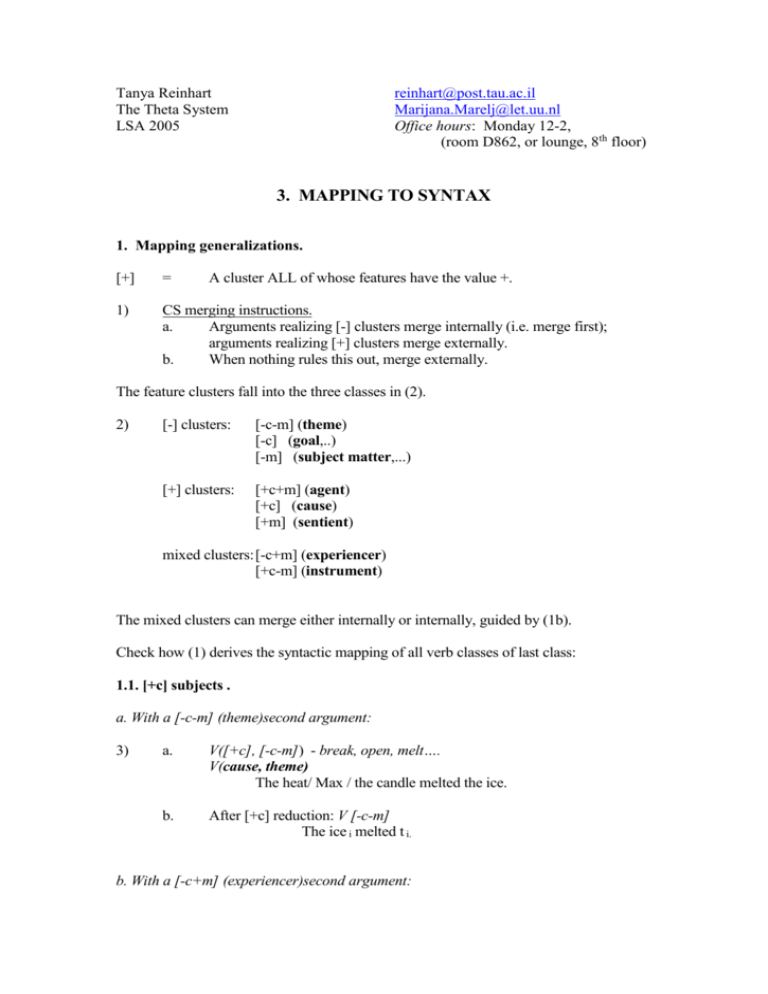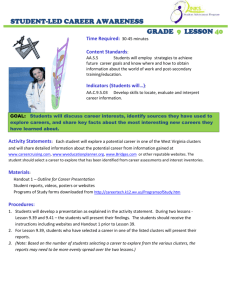3. mapping to syntax
advertisement

Tanya Reinhart The Theta System LSA 2005 reinhart@post.tau.ac.il Marijana.Marelj@let.uu.nl Office hours: Monday 12-2, (room D862, or lounge, 8th floor) 3. MAPPING TO SYNTAX 1. Mapping generalizations. [+] = A cluster ALL of whose features have the value +. 1) CS merging instructions. a. Arguments realizing [-] clusters merge internally (i.e. merge first); arguments realizing [+] clusters merge externally. b. When nothing rules this out, merge externally. The feature clusters fall into the three classes in (2). 2) [-] clusters: [-c-m] (theme) [-c] (goal,..) [-m] (subject matter,...) [+] clusters: [+c+m] (agent) [+c] (cause) [+m] (sentient) mixed clusters: [-c+m] (experiencer) [+c-m] (instrument) The mixed clusters can merge either internally or internally, guided by (1b). Check how (1) derives the syntactic mapping of all verb classes of last class: 1.1. [+c] subjects . a. With a [-c-m] (theme)second argument: 3) a. V([+c], [-c-m]) - break, open, melt…. V(cause, theme) The heat/ Max / the candle melted the ice. b. After [+c] reduction: V [-c-m] The ice i melted t i. b. With a [-c+m] (experiencer)second argument: 4) a. V ([+c], [-c+m] - worry,grieve amuse, surprise... , V(cause, experiencer) Max / the noise / the gun scared Lucie. b. After [+c] reduction: V [-c+m] Max worries 1.2. Verbs with two [/+c] clusters. 5) V ([+c+m], [-c-m], [+c-m])- drill, peel, surround… ( agent, theme, instrument) 6) Optionality generalization: When a verb selects two [/+c] roles, only one is obligatorily realized. (-The other, then, is present only in the semantics). 7) a. b. The army surrounded the village with a wall. A wall surrounds the village. 1.3. [-] verbs (two-place unaccusatives). 8) V ([-c-m] [-c]) – appeal, escape, elude, occur V (theme, goal (interpretable as experiencer)) 9) a. b. The solution surprised Max Max was surprised by the solution 10) a. b. The solution appealed to Max. *Max was appealed by the solution. 11) The solutioni appealed ti to Max. 2. Case generalizations. A central assumption in linguistics is that internal arguments of the verb receive either the structural Accusative Case, or an inherent Case mediated by a preposition or dative. However, not much is known regarding how this choice is formally determined, and to a large extent, this information is assumed to be listed individually for verb entries in the lexicon (or at least all verbs assigning a Case other than Accusative must be individually listed). In a more optimal setting, this information should be determined in a unified way for all verbs, based on their feature composition. 12) Some non accusative verbs (V([+c+m] [-c]): pray to (for), speak to (with), vote for, long for, look at 13) Lexicon marking Given an n-place verb-entry, n>1, a. A verb is marked with the Acc feature iff its grid includes both a [+] cluster and a fully specified cluster [α -c]. ([-c-m], [-c+m] introduce Acc, in the presence of a [+] cluster.) 14) a. b. [-c] clusters are realized usually as Dative or with to.1 [-m] clusters are realized as oblique (with some semantic impact carried by the preposition) . 3. The unaccusative problem. (For the full details of sections 3, 4, see Reinhart (2002 –'Overview"), section 3.) 15) Unaccusatives V[-c-m]: break, open, fall, freeze, melt, grow, develop, drown, defrost, spin, slide, swing, blush, wither, redden, age, alter, awake, blur, change, collapse, decompose, decrease, degrade, diminish, dissolve, die. 16) Theme unergatives V[-c-m]: glow, shine, beam, glare, glimmer, sparkle, babble, flash, buzz, click, whistle, squeal, stink, bleed, drip, sweat, radiate (L&R's 'emission verbs'); shudder, tremble, flower. 17) Agent unergatives V[+c+m]: walk, run, march, gallop, hurry, wander, dance, work. Other unergatives (V[+m?]): Laugh, cry, sleep. 4. The full system of mapping into syntax. 18 1 Lexicon marking (applies prior to lexicon operations like reduction) Given an n-place verb-entry, n>1, a. Mark the verb with the Acc feature iff its grid includes both a [+] cluster and a fully specified cluster [α -c]. b. Mark a [-] cluster with index 2. c. Mark a [+] cluster with index 1. The strong generalization is that whenever Dative case or to occur, the cluster is [-c]. There are hardly any exceptions found to this generalization across languages. There are however many instances of [-c] occurring with a preposition (oblique). There is more research available within the theta system regarding when this is the case. 19 CS merging instructions. a. An argument realizing a cluster marked 2 merges internally; An argument with a cluster marked 1 merges externally. b. When nothing rules this out, merge externally. 20) Lexicon operations reduce the Acc Case feature fully or partially (a topic we return to). 21) a. b. c. Base entry for (16): E.g. glow([-c-m]) Marking: inapplicable (one place entry) Merging: External by (19b). E.g. The diamond glowed. 22) a. b. c. d. Base entry for (15): E.g. freeze([+c], [-c-m]) marking: freezeacc ([+c]1, [-c-m]2 Reduction: freeze ([-c-m]2) Merging: Internal by (19a): The wateri froze ti 23) a. b. c. d. Base entry: worry ([+c], [-c+m]...) Marking: worry(acc) ([+c]1, [-c+m]...) Reduction: worry ([-c+m]) Merging: External by (19b): Max worried









